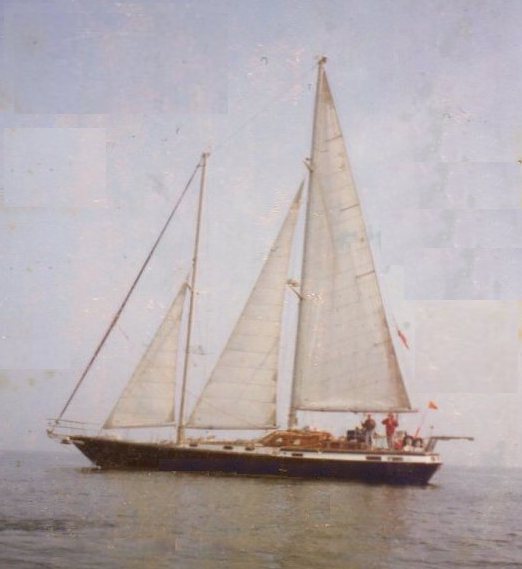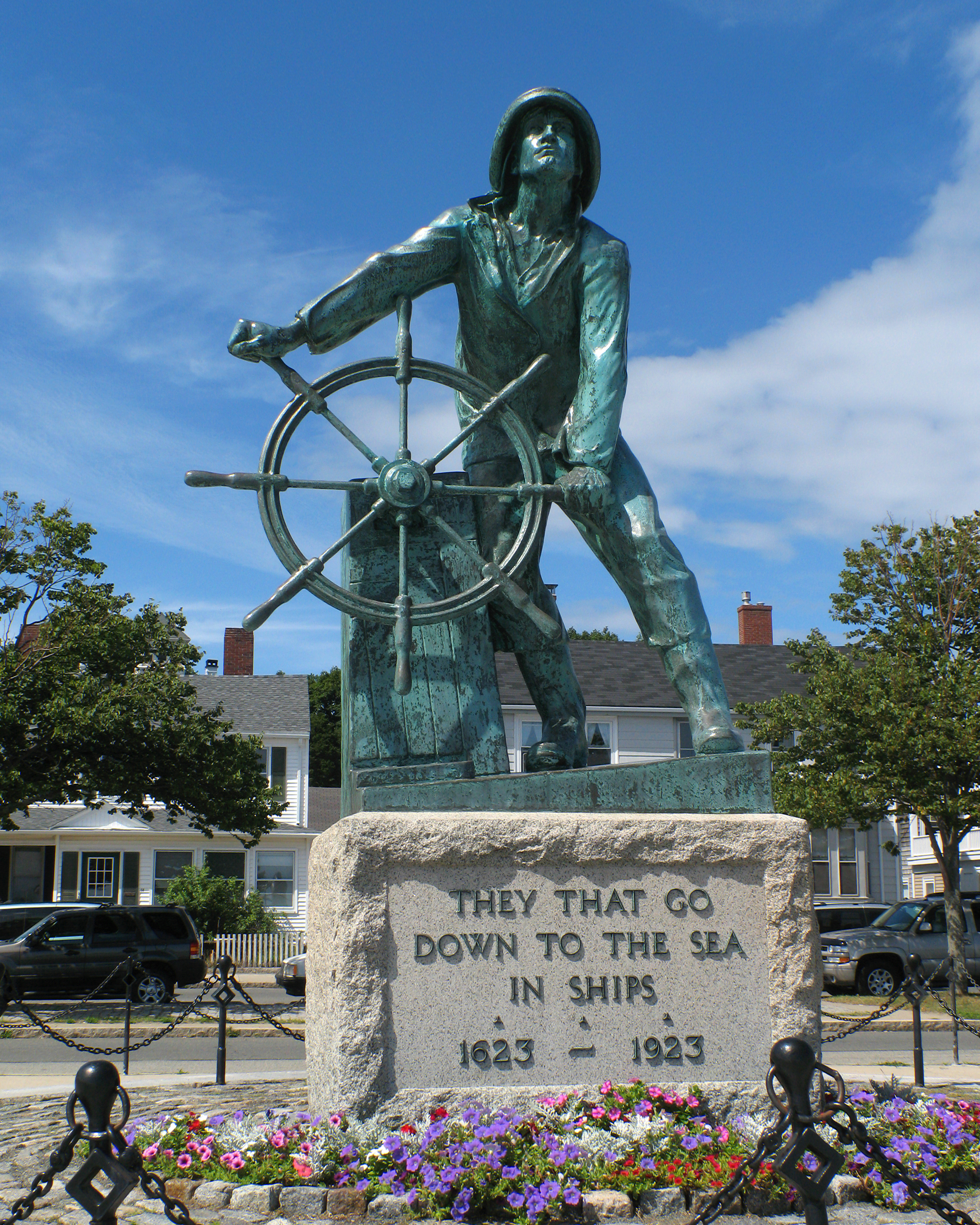|
Marlow-Hunter 47
The Marlow-Hunter 47 is an American sailboat that was designed by the Hunter Design Team as a cruiser and first built in 2016. Production The design was built by Hunter Marine in the United States, starting in 2016 and remained in production through 2019. Design The Marlow-Hunter 47 is a recreational keelboat, built predominantly of vinylester fiberglass, with a Nida-core sandwich and Kevlar reinforcing, with a hard chine hull. It has a fractional sloop B&R rig, a nearly plumb stem, a reverse transom with a fold-down swimming platform, telescoping ladder and a dinghy garage, an internally mounted spade-type rudder controlled by a wheel and a fixed deep fin keel or optional wing keel. The deep fin keel model displaces and carries of ballast, while the wing keel version displaces and carries of ballast. The boat has a draft of with the deep fin keel and with the shoal draft wing keel. The steering wheel is hydraulically-canting and can be pivoted though 90° as desired ... [...More Info...] [...Related Items...] OR: [Wikipedia] [Google] [Baidu] |
Hunter Design Team
Hunter Marine is an American boat builder, now known as Marlow-Hunter, LLC, owned by David E. Marlow. The company also produces the Mainship powerboat brand. Marlow also owns and manufactures the Marlow Yachts brand consisting of long range power cruisers in the 37 to 110 foot range. The company is based in Alachua, Florida. The first boat design was a 25-foot (7.6 meter) long sloop, and another noted design was the Ocean racing sailboat the HC 50. History In the 1800s Henry Luhrs, a German immigrant, outfitted trading ships and owned a chandlery. His grandson, Henry, continued the family heritage on the New Jersey coast, building and repairing recreational and fishing boats. By the early 1960s Henry and his sons, John and Warren, were building over a thousand powerboats a year. Hunter was started in 1973 in Alachua, Florida, as a sailboat manufacturer. The early Hunter boats were designed by John E. Cherubini. In 1988 the company ran into trouble, as the founder, Luh ... [...More Info...] [...Related Items...] OR: [Wikipedia] [Google] [Baidu] |
Kevlar
Kevlar (para-aramid) is a strong, heat-resistant synthetic fiber, related to other aramids such as Nomex and Technora. Developed by Stephanie Kwolek at DuPont in 1965, the high-strength material was first used commercially in the early 1970s as a replacement for steel in racing tires. It is typically spun into ropes or fabric sheets that can be used as such, or as an ingredient in composite material components. Kevlar has many applications, ranging from bicycle tires and racing sails to bulletproof vests, all due to its high tensile strength-to-weight ratio; by this measure it is five times stronger than steel. It is also used to make modern marching drumheads that withstand high impact; and for mooring lines and other underwater applications. A similar fiber called Twaron with the same chemical structure was developed by Akzo in the 1970s; commercial production started in 1986, and Twaron is now manufactured by Teijin. History Poly-paraphenylene terephthalami ... [...More Info...] [...Related Items...] OR: [Wikipedia] [Google] [Baidu] |
Marlow-Hunter 50
The Marlow-Hunter 50 is an American sailboat that was designed by the Hunter Design Team as a cruiser and first built in 2010. The design was originally marketed by Hunter Marine as the Hunter 50 AC (for ''Aft Cockpit''), but the company became Marlow-Hunter in 2012 and the boat was renamed the Marlow-Hunter 50. Production The design was built by Hunter Marine in the United States starting in 2010 and remained in production in 2019. Design The Marlow-Hunter 50 is a recreational keelboat, built predominantly of fiberglass. It has a B&R rig masthead sloop rig, a raked stem, an aft cockpit, a walk-through reverse transom with a swimming platform and folding ladder, an internally mounted spade-type rudder controlled by dual wheels and a fixed fin keel or wing keel. The fin keel version it displaces and carries of ballast, while the wing keel version displaces and carries of ballast. The boat has a draft of with the standard keel and with the optional shoal draft ... [...More Info...] [...Related Items...] OR: [Wikipedia] [Google] [Baidu] |
Hunter HC 50
The Hunter HC 50 is an American sailboat that was designed by the Hunter Design Team as a "long distance express cruiser" and first built in 2000. The HC 50 is a development of the one-off racers ''Hunter's Child'' and ''Route 66'', with a design goal of producing a fast cruising sailboat. The ''HC'' designation is an acknowledgment of its design ancestry. The design designation can be confused with the Hunter 50 CC of 2009 and the Hunter 50 AC of 2010. Production The design was built by Hunter Marine in the United States starting in 2000, but it is now out of production. Design The Hunter HC 50 is a recreational keelboat, built predominantly of vacuum bag moulded fiberglass, with a foam-core deck. It has a cutter rig, a raked stem, a walk-through open reverse transom with a swimming platform and folding ladder, an internally mounted spade-type rudder controlled by a tiller and a fixed fin keel. It displaces and carries of lead ballast in the keel and also of flooding ... [...More Info...] [...Related Items...] OR: [Wikipedia] [Google] [Baidu] |
C&C 50
The C&C 50 is a Canadian sailboat, that was designed by C&C Design and first built in 1972. Production The design was built by C&C Yachts in Canada between 1972 and 1975, but it is now out of production. Design The C&C 50 is a small recreational keelboat, built predominantly of fibreglass, with wood trim. It has a masthead sloop rig, an internally-mounted spade-type rudder and a fixed fin keel. It displaces and carries of ballast. The boat has a draft of with the standard keel fitted. The boat is fitted with a Westerbeke 4-107 diesel engine of . The design has a PHRF racing average handicap of 51 with a high of 33 and low of 72. It has a hull speed of . See also *List of sailing boat types Similar sailboats * Hunter 49 * Hunter HC 50 * Marlow-Hunter 47 *Marlow-Hunter 50 *Marlow-Hunter 50 Center Cockpit The Marlow-Hunter 50 Center Cockpit, also called the Marlow-Hunter 50CC is an American sailboat that was designed by the Hunter Design Team as a cruiser and first b ... [...More Info...] [...Related Items...] OR: [Wikipedia] [Google] [Baidu] |
List Of Sailing Boat Types
The following is a partial list of sailboat types and sailing classes, including keelboats, dinghies and multihull ( catamarans and trimarans). Olympic classes World Sailing Classes Historically known as the IYRU (International Yacht Racing Union), the organization evolved into the ISAF (International Sailing Federation) in 1996, and as of December 2015 is now World Sailing. Dinghies Keelboats & yachts Multihulls Boards Radio-controlled Former World Sailing-classes Dinghies Keelboats & yachts Multihulls Boards Other classes and sailboat types Dinghies Keelboats & yachts Multihulls See also * Classic dinghy classes * List of boat types * List of historical ship types * List of keelboat classes designed before 1970 * Olympic sailing classes * Small-craft sailing * Clansman 30 Notes References {{DEFAULTSORT:Sailing boat types Types * Boat types A boat is a watercraft of a large range of types and sizes, but ge ... [...More Info...] [...Related Items...] OR: [Wikipedia] [Google] [Baidu] |
Robert Perry (yacht Designer)
Robert H. Perry is a U.S. yacht designer based in Seattle, Washington. Among his designs are some of the most successful cruising yachts in modern cruising such as the Tatoosh 42, Tayana 37 and Valiant 40. Through his career he has designed boats for many well recognized names in the yachting industry, such as Tayana, Cheoy Lee, Valiant, Baba, Ta Shing, Islander, Passport and Saga. Perry has taught yacht design at Evergreen State College. Early life In 1957 when Robert H. Perry was twelve, he and his family moved from Sydney, Australia to Vancouver, British Columbia. He writes that the trip made a lasting impression on him and spurred his interest in yacht design. At the beginning of his ninth-grade year, his family moved to Mercer Island, Washington, an area renowned for its school system. Here, his interest in sailboats really clicked. He met famous designer William Garden, joined the local yacht club, and excelled at mechanical drawing. Perry graduated with a 1.69 GP ... [...More Info...] [...Related Items...] OR: [Wikipedia] [Google] [Baidu] |
Mainsail
A mainsail is a sail rigged on the main mast of a sailing vessel. * On a square rigged vessel, it is the lowest and largest sail on the main mast. * On a fore-and-aft rigged vessel, it is the sail rigged aft of the main mast. The sail's foot is normally attached to a boom. (In extremely heavy weather, the mainsail may be lowered, and a much smaller trysail hoisted in its place). Historical fore-and-aft rigs used a four-sided gaff rigged mainsail, sometimes setting a gaff topsail above it. Whereas once the mainsail was typically the largest sail, today the mainsail may be smaller than the jib or genoa; Prout catamarans typically have a mainmast stepped further aft than in a standard sloop, so that the mainsail is much smaller than the foresail. Bermuda rig The modern Bermuda rig uses a triangular mainsail aft of the mast, closely coordinated with a jib for sailing upwind. A large overlapping jib or genoa Genoa ( ; it, Genova ; lij, Zêna ). is the capital of ... [...More Info...] [...Related Items...] OR: [Wikipedia] [Google] [Baidu] |
Roller Furling
Roller furling is a method of furling (i.e. reefing) a yacht's staysail by rolling the sail around a stay. Roller furling is typically used for foresails such as jibs or genoas. A mainsail may also be furled by a similar system, whereby the sail is furled within the mast or around a rotating boom (or around a rotating shaft within a boom). Although staysail roller-furling is effective and very common, in-mast or in-boom mainsail furling involves some compromises, and mainsail slab reefing gives a better sail shape. Methods The idea for a furling jib is usually attributed to Major E du Boulay in England who invented a device similar to a roller blind for reefing a jib. Major Wykeham-Martin used one of Boulay's rollers and improved the system by incorporating roller bearings in 1907 when the system was patented. The original castings were made by London-based toilet makers Bouldings. By the 1940s nearly every British cruising yacht was fitted with this furling system. An earl ... [...More Info...] [...Related Items...] OR: [Wikipedia] [Google] [Baidu] |
Keel
The keel is the bottom-most longitudinal structural element on a vessel. On some sailboats, it may have a hydrodynamic and counterbalancing purpose, as well. As the laying down of the keel is the initial step in the construction of a ship, in British and American shipbuilding traditions the construction is dated from this event. Etymology The word "keel" comes from Old English , Old Norse , = "ship" or "keel". It has the distinction of being regarded by some scholars as the first word in the English language recorded in writing, having been recorded by Gildas in his 6th century Latin work '' De Excidio et Conquestu Britanniae'', under the spelling ''cyulae'' (he was referring to the three ships that the Saxons first arrived in). is the Latin word for "keel" and is the origin of the term careen (to clean a keel and the hull in general, often by rolling the ship on its side). An example of this use is Careening Cove, a suburb of Sydney, Australia, where careening was carried ... [...More Info...] [...Related Items...] OR: [Wikipedia] [Google] [Baidu] |
Ship's Wheel
A ship's wheel or boat's wheel is a device used aboard a water vessel to steer that vessel and control its course. Together with the rest of the steering mechanism, it forms part of the helm. It is connected to a mechanical, electric servo, or hydraulic system which alters the horizontal angle of the vessel's rudder relative to its hull. In some modern ships the wheel is replaced with a simple toggle that remotely controls an electro-mechanical or electro-hydraulic drive for the rudder, with a rudder position indicator presenting feedback to the helmsman. History Until the invention of the ship's wheel, the helmsman relied on a tiller—a horizontal bar fitted directly to the top of the rudder post—or a whipstaff—a vertical stick acting on the arm of the ship's tiller. Near the start of the 18th century, a large number of vessels appeared using the ship's wheel design, but historians are unclear when the approach was first used. Design A traditional ship's wheel is comp ... [...More Info...] [...Related Items...] OR: [Wikipedia] [Google] [Baidu] |
Dinghy
A dinghy is a type of small boat, often carried or towed by a larger vessel for use as a tender. Utility dinghies are usually rowboats or have an outboard motor. Some are rigged for sailing but they differ from sailing dinghies, which are designed first and foremost for sailing. A dinghy's main use is for transfers from larger boats, especially when the larger boat cannot dock at a suitably-sized port or marina. The term "dinghy towing" sometimes is used to refer to the practice of towing a car or other smaller vehicle behind a motorhome, by analogy to towing a dinghy behind a yacht. Etymology The term is a loanword from the Bengali ', Urdu ', and Hindi '. Types Dinghies usually range in length from about . Larger auxiliary vessels are generally called tenders, pinnaces or lifeboats. Folding and take-down multi-piece (nesting) dinghies are used where space is limited. Some newer dinghies have much greater buoyancy, giving them more carrying capacity than old ... [...More Info...] [...Related Items...] OR: [Wikipedia] [Google] [Baidu] |







